Battle Ropes
Think you can’t do many exercises or get a decent workout with battle ropes? Well, think again.
When I first saw a battle rope, these were my thoughts, and I was thinking of how I could get a good workout with just a single rope. Well, I can tell you that after doing five 30-second rounds of all-out up and down waves, it was one of the most intense and enjoyable upper body workouts that I have ever done. It fired up every muscle in my body, especially my arms and shoulders. As a result, I now use the battle rope as a conditioning tool as part of my upper body training.
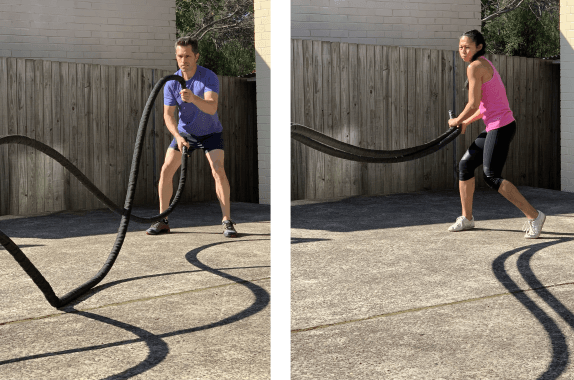
Battle rope training is definitely an all-in-one strength and cardio workout.
Advantages of battle ropes
Most high-intensity exercises and circuits these days focus on using the legs that involve some form of running and jumping.
One unique advantage of the battle rope is that although you engage every muscle in the body, you primarily use the upper body propelled by the arms and shoulders. Additionally, because it’s a non-impact exercise system, the risk of injury is minimal.
Another advantage is that it helps to correct any imbalances that you might have. For example, when you perform the up and down waves, you might notice that your more dominant side may create bigger waves and be more coordinated than the less dominant side. The more you practice and train with the ropes over time, the stronger and more conditioned both sides will become, and any imbalances will eventually even out.
What size rope should I use?
Battle ropes come in various lengths and thicknesses. Typically, the standard sizes are 9 metres (30ft), 12 metres (40ft) or 15 metres (50ft) in length and 38mm (1.5”) or 50mm (2”) thick. The longer and thicker the rope, the heavier it is and the more challenging it will be to use.
If you are a beginner, you may want to start with the shorter, lighter rope. The only problem is that once you start using the rope consistently, you will become stronger and fitter and will need to get a longer rope to stay challenged.
That’s why I use and recommend a 15 metre (50ft) x 38mm (1.5”) rope. If it’s challenging when you first use it, wrap it around the anchor point a few times to achieve the desired length. As you get stronger and more conditioned, you can lengthen the rope to become more challenging.
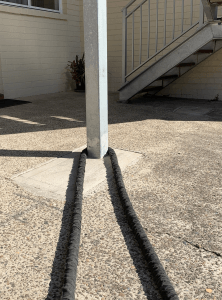
How to set up the rope
The battle rope is easy to set up. Just anchor it to a solid structure or wrap it around a secure pole as we do.
Do not attach it to any moveable object. Once the rope is securely attached, make sure the rope is of equal length and you’re ready to start.
Grip position
The two main hand grips are the overhand and underhand grip positions.
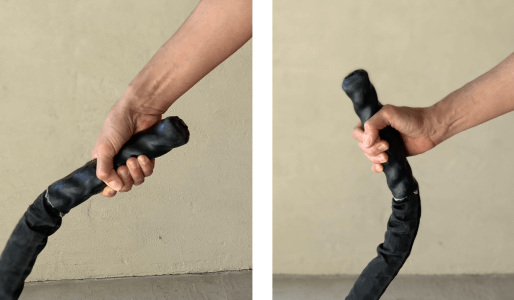
|
Overhand |
Underhand |
Getting started
Grab both ends of the rope in each hand and hold the rope with tension.
Next, take a big step forward towards the anchor point to have a little slack on the rope, and place your feet shoulder-width apart.
Hip-hinge and sit back on your hips while engaging your core muscles and maintaining a straight back. This will put you in a strong position that will help you maintain your balance and prevents the rope from pulling you forward when performing an exercise.
This will be your starting position.
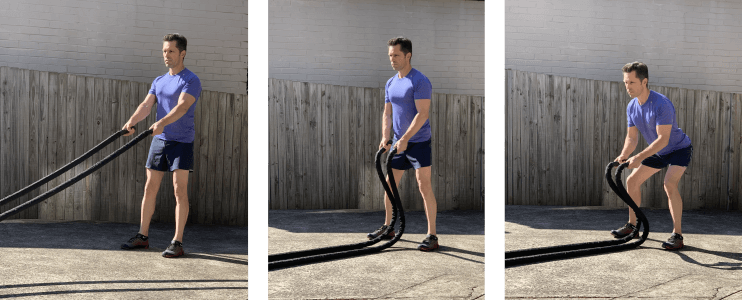
Performing your first exercise - Up and down waves
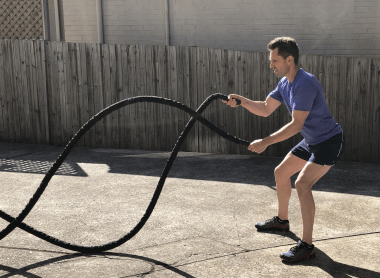
Once in the starting position, hold the rope with an overhand grip and move your arms up and down, creating waves with the rope. Aim at forming equal waves that travel the length of the rope to the anchor point.
It’s essential to keep the wrists, arms, and shoulders nice and relaxed so that you create even, smooth waves. Next, practice and master your technique and then progress to other exercises.
Learn to relax
When I was a sprinter, I learned to relax under tension. I remember my coach telling me that I needed to relax when sprinting. This meant that I could maintain my top speed for a longer distance without tightening up. As a result, my times improved.
The same applies to battle rope training. When you don’t grip the rope too tight and relax your body, especially your wrists, arms, and shoulders, you will be able to maintain speed and intensity for more extended periods without tiring too quickly.
References:
‘The Definitive Guide to Battling Ropes’ by Brad Longazel, 2012
‘How to Use Battle Ropes and their Popular Exercises’ by Sam Page